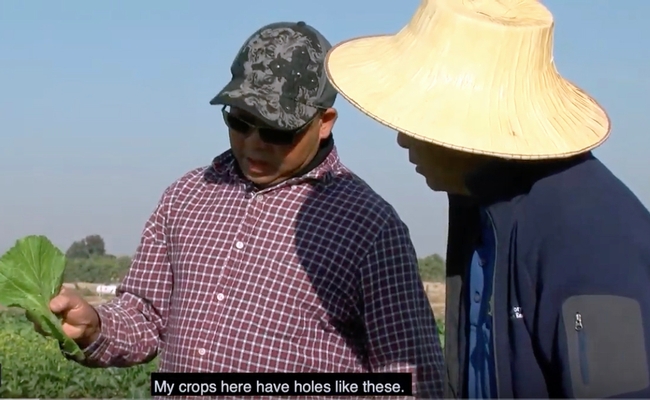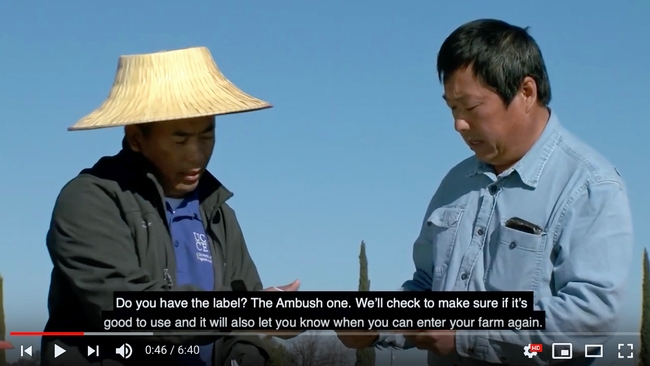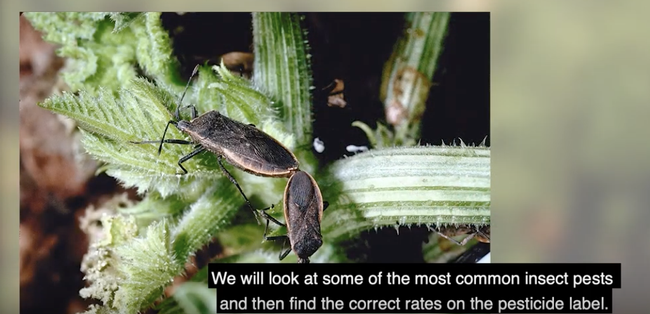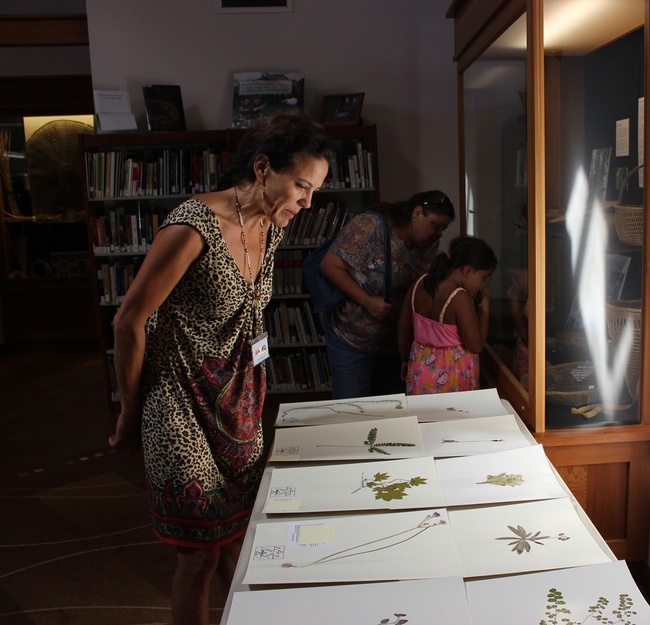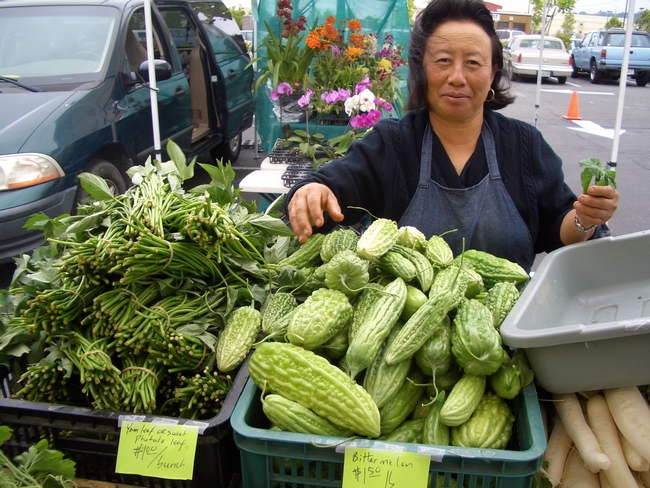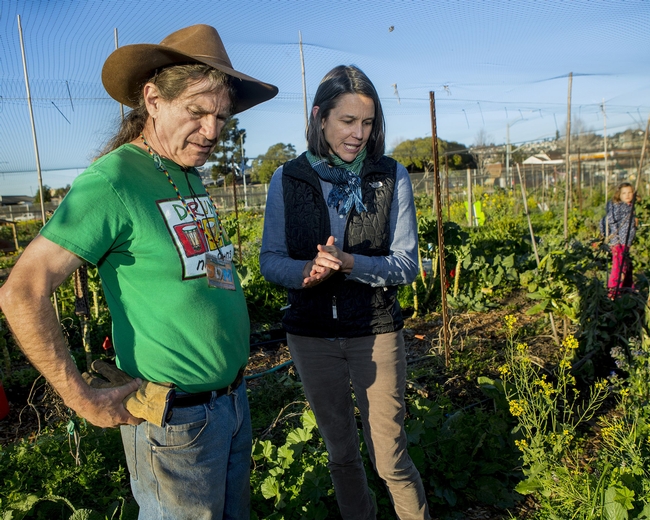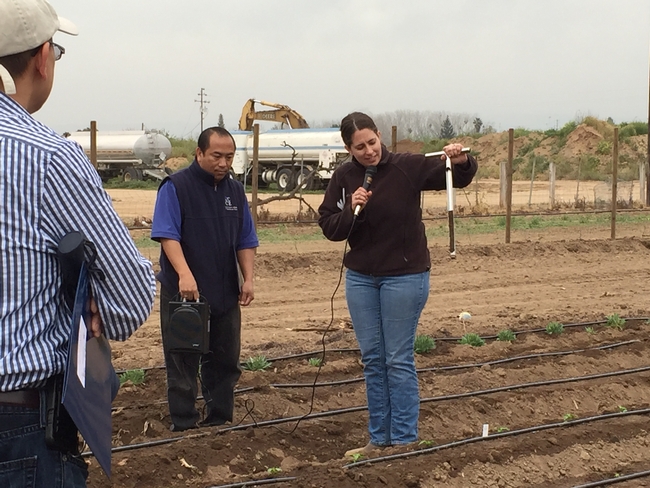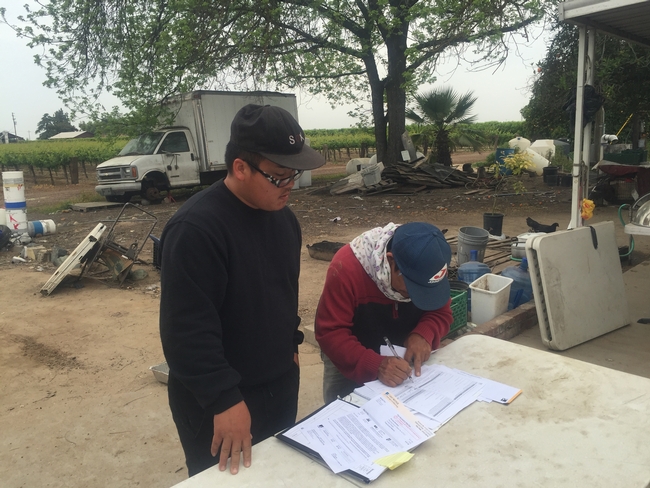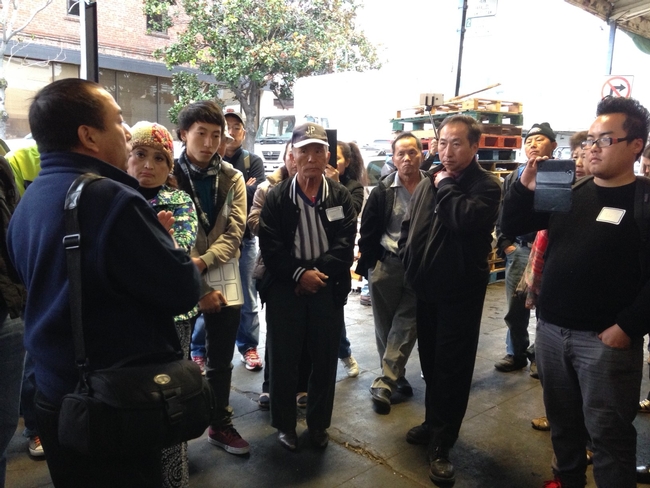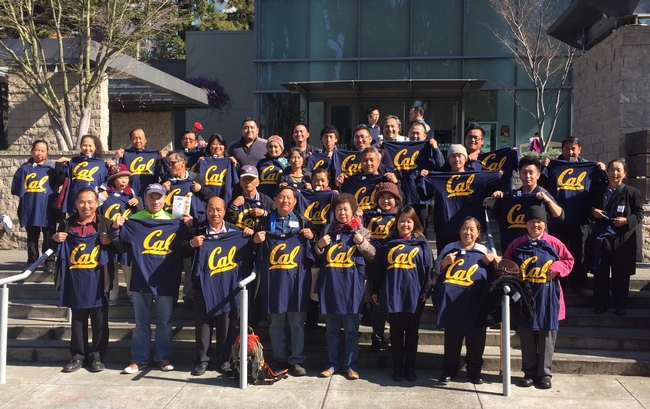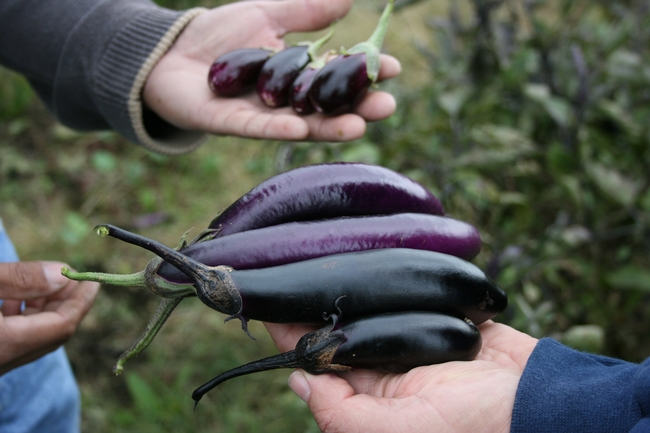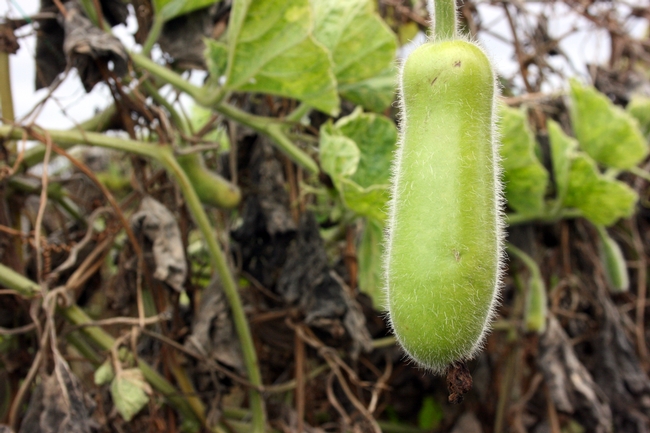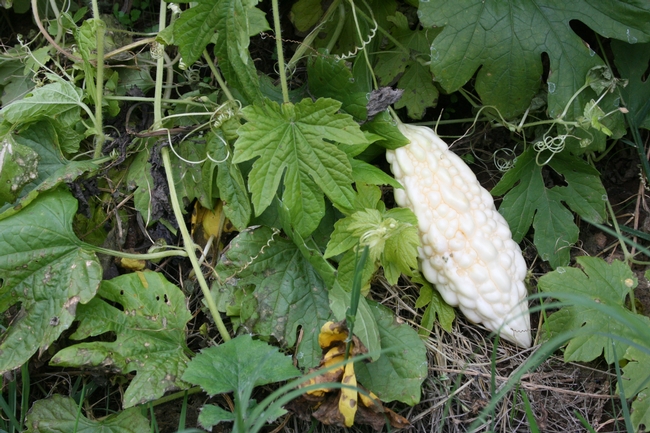Posts Tagged: Hmong
Hmong-language pesticide safety videos now online
DPR, Fresno State and UCCE create pesticide safety videos with Hmong farmers
A series of videos describing California pesticide rules and safety in Hmong is now available to view for free online. The videos were produced by California State University, Fresno and UC Cooperative Extension in Fresno County with funding from the California Department of Pesticide Regulation.
The nine-part video series – Complying with Pesticide Laws and Regulations in California – is part of DPR's mission to reach California's farming communities. The videos cover a number of topics including using personal protective equipment, understanding pesticide product labels and application permit requirements.
The innovative educational tool blends peer-to-peer communication with traditional extension methods to include the knowledge and experience of both farmers and extension experts. Hmong farmers featured in the video helped develop scenes in which they educate other farmers, purchase and use personal protective equipment, and interact with extension staff.
“We worked with Hmong farmers who are following pesticide regulations themselves, and are now giving back to educate their peers,” said Ruth Dahlquist-Willard, UC Cooperative Extension small farm advisor, who collaborated on the video production. “Their voices and expertise helped make the scenarios more realistic and accessible to other farmers in the Southeast Asian community.”
Michael Yang, longtime UC Cooperative Extension small farms and specialty crops agricultural assistant, stars in the videos, interacting with farmers based on his extensive experience and trusted relationships in the Hmong farming community, and narrating the educational content in Hmong.
“We hope the videos broaden the reach of our local extension programming to help more farmers understand pesticide regulations and avoid fines, as well as improve their safe handling, selection and use,” said Yang.
Dahlquist-Willard and Yang plan to show the videos at UC Cooperative Extension meetings with Hmong farmers and distribute copies on flashdrives to county Agricultural Commissioner's offices in Fresno County and beyond. The videos are captioned in English.
“DPR works with all types of farmers on pesticide issues and it's critical that they use these tools safely – regardless of the language they speak,” explained DPR Director Val Dolcini. “This video project, the first of its kind to use Hmong speakers, will help foster safer use of pesticides.”
The videos can be viewed at http://bit.ly/fs-dpr-hmong-pesticide-video. The modules in the series cover:
- Introduction to California Pesticide Laws
- Checking for Crops Registered on the Label
- Pests and Application Rates on the Label
- Understanding Signal Words
- Following the Restricted Entry Interval (REI)
- Following the Pre-harvest Interval (PHI)
- Knowing Common Restrictions on the Label
- Using Personal Protective Equipment (PPE)
- Pesticide Permits and Reporting requirements
The project took 700 hours over 18 months to complete, including filming and post-production. Twelve Fresno State students were also involved in producing the videos with the Hmong farmers in Fresno County. Dahlquist-Willard and Yang provided the creative direction in partnership with the farmers involved, and Fresno State's MCJ Multimedia Production Service under Professor Candace Egan brought professional video production and editing skills to make a high-quality finished product. Fresno State student video editor Mali Lee, a fluent Hmong speaker, completed the final edits of the Hmong language material.
“This was one of the most rewarding projects I have ever worked on,” said project director Bill Erysian of Fresno State. “We brought together a unique group of agricultural specialists, students, farmers and video professionals to create a high impact, professional set of educational videos on pesticide compliance for our Hmong farmers here in California.”
DPR has comprehensive pesticide safety and outreach material available in Punjabi, Spanish and English at https://www.cdpr.ca.gov/docs/whs/worker_protection.htm.
Continuing the mission of UC Cooperative Extension
Jennifer Sowerwine helps restore culturally relevant food systems to immigrant and Native American populations
The Karuk Tribe once lived on more than a million acres in remote Northern California. Legally, their ancestral land along the middle section of the Klamath River in Siskiyou County was in the public domain, as the Karuk did not have a reservation. But on May 6, 1905, when President Theodore Roosevelt created the Klamath Forest Reserve, the tribe lost any claim to its aboriginal territory.
Less swiftly but just as conclusively, the tribe also lost access to much of what the rivers and mountains provided: deer and elk, salmon, tan oak acorns, mushrooms, berries, medicinal herbs. And it lost its ability to manage the landscape through prescribed fire in order to ensure the survival of the plants and animals it needed. The Karuk's food system had been broken almost overnight, and has yet to recover. But Jennifer Sowerwine — UC Cooperative Extension specialist in the UC Berkeley College of Natural Resources — believes it still can.
In direct collaboration with Karuk tribal leaders and community members, as well as with the nearby Yurok and Klamath Tribes, Sowerwine has helped put millions of dollars from USDA to work restoring food security — defined as access to sufficient, healthy, and culturally appropriate foods — among those from whom it was once taken.
While this is a challenge to which one could easily dedicate a career, Sowerwine's broader mission to support equitable food systems across the state has also led her to other projects and other communities. In the Central Valley, she has spent years working with Southeast Asian farmers. Closer to home, she recently began studying how community farms and gardens improve food security among at-risk populations in the urban East Bay.
Restoring ancient relationships to food
Sowerwine's body of work is a manifestation of the University of California Cooperative Extension's long-standing mandate to aid the “welfare, development, and protection of California agriculture, natural resources, and people.” CNR is the home of Cooperative Extension at UC Berkeley, which — now celebrating 150 years since its founding as a land-grant university — is intended to benefit all residents of our increasingly populous and diverse state.
That includes California's first residents: Native tribes like the Karuk, the Yurok (located along the lower stretch of the Klamath River), and the Klamath (upriver, across the border in Oregon). All three were traditionally non-agrarian, hunter-gatherer communities. Loss of ancestral lands that had sustained them for millennia affected not only their diet — leading to a reliance on institutional and heavily processed foods that have contributed to persistent health problems —but also their culture.
In working with the tribes, Sowerwine first had to listen.
“One of the main philosophical approaches in my work is to collaborate with the community to identify what the problems are, co-create research questions, and then support, on the extension side, the kinds of programs they need to attain their goals,” she said.
Among the Karuk, the tribe with which Sowerwine works most closely, “the community is actively engaged in exploring ways to revitalize their eco-cultural system,” she said. “That includes managing the landscape with traditional methods to improve the productivity and availability of cultural foods and fibers, and restoring some of the relationships around Traditional Ecological Knowledge (TEK).”
Beginning in 2012, through a five-year, USDA-funded grant, Sowerwine partnered with all three tribes to help them reclaim control over their food systems using a holistic, community-centered approach. This took a variety of forms, including designing K–12 curricula for local schools around traditional food systems; opening two new herbaria to preserve and share specimens of native food plants; hosting workshops on subsistence skills like butchering, bread making, and canning; and finding appropriate ways of reintroducing sustainable local agriculture into communities for whom traditional farming is linked with colonialization.
This work now serves as a model for tribes across the country.
“There's a lot of interest in all of our programs,” says Karuk tribal member and Pikyav Field Institute program manager Lisa Hillman. In particular, the tribe created a digital library to offer easy access to information about traditional foods and ecological knowledge, which has attracted significant acclaim and earned Hillman invitations to discuss it at national conferences. “Working with [Jennifer] opened a whole lot of doors for our tribe,” Hillman says. The project's success also led to a second, three-year USDA grant that should continue to point the way forward and help mitigate some past harms for the Karuk Tribe.
Interventions for Southeast Asian refugee farmers
Sowerwine began her career studying food security among marginalized residents of a very different part of the world, who nonetheless have much in common with her current collaborators. As a doctoral candidate in the Department of Environmental Science, Policy, and Management (ESPM) at Berkeley, she spent two years in the highlands of Vietnam learning how land-use laws and economic policies affected indigenous local farmers from the Mien minority ethnic group and their ability to sustain agrarian practices that were vital to their culture and food security.
After earning her PhD, Sowerwine continued at Berkeley as a postdoctoral researcher. A vibrant community of Mien immigrants exists not far away, in Sacramento, where refugees of the Vietnam War first arrived from Laos in the late 1970s. They were joined by fellow refugees from the Hmong ethnic group, many of whom settled in Fresno. Both groups had traditionally worked the land in Southeast Asia, and they soon developed robust farming networks here in California.
Using a proficiency with the Vietnamese language honed overseas, Sowerwine initially set out to assess the productivity and economic viability of these small farms operated by Southeast Asian refugees.
“I wanted to understand the barriers they were facing in terms of farming in the Central Valley of California, which is arguably the most industrialized agricultural landscape in the world,” she said.
Approximately 100 Mien farmers — part of a Sacramento-area Mien population of about 15,000 — work small plots of land, averaging about eight acres each, outside the state capital. They primarily grow strawberries to sell at roadside stands, but also produce a wide variety of traditional foods, like “sticky” corn, yu choy, gai lan, purple long beans, and bitter melon — mostly for home consumption.
Hmong farmers, who are concentrated in Fresno and Sacramento counties, grow conventional vegetables like cherry tomatoes, green beans, onions, and lettuce — in addition to their own cultural and traditional foods — to sell at farmers markets, Asian grocery stores, and wholesale markets.
The two groups' successes have not come easy, owing to such challenges as language barriers, differences between traditional and modern farming techniques, and informal labor practices that often clash with state regulations.
In response, Sowerwine designed and led an array of interventions to support the farms' continued viability. These included offering hands-on, native-language training to help Hmong and Mien farmers comply with complex labor and food-safety regulations; teaching farmers how to achieve organic certification or to make and sell “value-added” foods like jams; and providing assistance in accessing new markets for fresh produce, including schools, farmers markets, and wholesalers.
Throughout her career, Sowerwine has worked closely with UC Cooperative Extension advisors around the state, including Richard Molinar — a now-retired small farms and specialty crops advisor in Fresno County — and his successor, Ruth Dahlquist-Willard.
“We accomplished a lot, and we helped hundreds, if not thousands,” Molinar said.
Protecting farmers' livelihoods is only the start, Sowerwine notes. Positive outcomes ripple out to the broader immigrant community, which sees strengthened food security through a steady supply of affordable, culturally appropriate produce, and to the entire regional economy and food system, which benefit from a robust and diverse network of local food producers.
“The land-grant universities were founded for the ordinary people, and not just the elite,” Dahlquist-Willard said. “The original idea was to provide support and training for people in professions like agriculture. It's part of the health of rural communities.”
The power of small-scale urban agriculture
Yet as Sowerwine's work in the East Bay has shown, small-scale agriculture can also be critical to the health and well-being of urban residents — especially recent immigrants. In 2016, she and a team of 12 undergraduate research assistants surveyed more than 100 community, school, and for-profit farms and gardens between Hayward and Richmond. A dozen of the community gardens were included in a subsequent pilot study to learn more about how urban farms can provide immigrants with reliable access to affordable traditional foods.
Despite a combined area of just 10.5 acres, these plots were producing more than 300 distinct crops. Many of these plants have direct ties to specific culinary and medicinal traditions, including nine varieties of edible cactus used for nopales (cactus pads) and tuna (cactus fruit) in Mexican cuisine, and even as a diabetes remedy; gandana, also known as Afghan leek, a critical ingredient in the traditional dishes bolani and ashak; and chinsaga (Cleome gynandra), a plant used by Kenyan women for postpartum healing and infant health.
Late last year, in collaboration with the Berkeley Food Institute, Sowerwine received a grant from the national nonprofit Foundation for Food and Agriculture Research to further promote and study Bay Area urban farming. Along with ESPM faculty members Timothy Bowles and Céline Pallud, as well as Charisma Acey from the College of Environmental Design, she'll delve even deeper into urban agriculture across the Bay Area.
The team plans to address a diverse and thought-provoking array of questions, most of which have never been studied so thoroughly in the Bay Area. For example, what is the role of urban farms in supporting beneficial insects and improving soil health? How does food from urban farms find its way to consumers and how can waste along the way be minimized? What cultural or structural barriers may prevent locals from accessing urban-farming products?
As with all of Sowerwine's work, from the Oregon border to the East Bay, the goal is not simply to learn more, but to make a difference.
“There's a need to elevate an understanding of the value and importance of these spaces to local, state, and national government, to figure out ways of securing them for the long-term benefit of our diverse California public,” Sowerwine said. “The goal is to inform policy and create opportunities for tribal communities and small-scale family and urban farmers, to maintain the continuity of their cultural food heritages.”
Hmong farmers getting help from UC Cooperative Extension to weather the drought
“Sometimes we don't see the farmers that often. They are busy on the farm,” Yang said. “But when they hear something (important) like this on the radio, they show up.”
UC Cooperative Extension office staff - including UCCE advisor Ruth Dahlquist-Willard, Yang, part time staffer Xia Chang, Fresno State student volunteer Sunny Yang, and research assistant Janet Robles from Fresno State's Center for Irrigation Technology – are working with small-scale and socially disadvantaged farmers one-on-one to line up the necessary paperwork and information to submit successful grant applications. (Read more about UC staffer Xia Chang, millennial Hmong farmer.)
“We helped eight farmers submit applications in the last two rounds, and seven received grants,” Yang said. “The money is significant.”
The grants allowed the farmers to make improvements in energy efficiency and water savings, Dahlquist-Willard said.
“This can make a huge difference for the profitability of a small farm,” she said.
The application requires energy bills from the previous growing season, a pump test and a plan for redesigning the irrigation system to result in reduced water use and reduced greenhouse gas emissions.
“There are a lot of calculations to do,” Yang said. “It's very complicated, and no one is available to help underserved farmers.”
While assisting farmers with applications for other programs is not usually part of UCCE's extension efforts, the small farms program in Fresno County has identified this form of assistance as crucial to the success of small-scale and minority-operated farms.
Help with the State Water Efficiency and Enhancement Program (SWEEP) grants is one in a series of outreach efforts for Hmong farmers spearheaded by Dahlquist-Willard since she was hired in 2014 to work with small-scale farmers in Fresno and Tulare counties. After just two weeks on the job, she was invited to an emergency meeting with the National Hmong American Farmers and USDA's Farm Service Agency to address the challenges faced by Hmong farmers as groundwater levels continued to drop during the drought.
“Wells were starting to dry up. Some Hmong farmers were reportedly calling suicide hotlines,” Dahlquist-Willard said. “We knew we had to take action.”
Dahlquist-Willard and her staff began researching programs that could offer the farmers financial assistance. They identified a free PG&E rate analysis, which could help the farmers choose the best electric rate for their irrigation practices to minimize charges. They searched for financing to deepen wells for farmers who had difficulty qualifying for existing USDA loans. And in 2015, they began helping farmers with applications for the State Water Efficiency and Enhancement Program.
The dire circumstances also prompted Dahlquist-Willard to commission a survey of Hmong farmers to see how they were impacted by the drought. Documenting their plight would be useful in seeking support. The survey was conducted in conjunction with outreach efforts with Fresno Regional Workforce Investment Board and Jennifer Sowerwine, UCCE Cooperative Extension specialist in the Department of Environmental Science, Policy and Management at UC Berkeley. The survey was funded with a grant from the USDA Office of Advocacy and Outreach and with support from UC Agriculture and Natural Resources via Sowerwine.
Sixty-eight farmers were interviewed by phone or in-person. Twenty-two percent said their wells had dried up, and 51 percent reported a decreased water flow.
“For the ones with dry wells, it could be $20,000 to $50,000 to drill a new well,” Dahlquist-Willard said. “A lot of them cannot get access to loans.”
To deal with irrigation water limitations, some farmers told interviewers they reduced acreage or changed the time of day they irrigate. Some stopped farming all together.
“One farmer told us he was irrigating his crops with his domestic well,” Dahlquist-Willard said.
Energy efficiency programs turned out to be very important for this population of farmers. Eighty-seven percent said their utility bills increased during the drought. As a result, UCCE has been promoting PG&E programs for energy efficiency as well as the SWEEP program.
The survey also showed the power of radio in reaching the Hmong farming community. Eighty percent of the survey respondents said they were regular listeners to Michael Yang's Central Valley Hmong Agriculture radio show.
Xia Chang: Millennial Hmong farmer
Xia (pronounced “sigh”) Chang, 26, was hired in 2015 to use his Hmong language skills in collecting survey responses for UCCE. Chang was born in Thailand, and immigrated with his family to the U.S. four years later. His father cultivates Southeast Asian vegetables along with a second job at Red Lobster. Many of the nine children in the family help out on the farm.
Chang attended college, but his financial aid was depleted before he earned a degree. In addition to part time work with UCCE, Chang is now farming.
“Last year we expanded our farm from 4 acres to 14 acres, with a new three-year lease,” Chang said.
The family's many technical agricultural questions led to Chang's frequent visits to the Cooperative Extension office, and ultimately to his being hired to help conduct the Hmong farmer survey.
“I spend a lot of time speaking Hmong on this job,” Chang said. “I've had to learn a lot of new vocabulary.”
He said he's also learning a lot about new farming techniques that he wants to apply on the family farm. However, there are obstacles.
“My dad is not open to new ways because he is afraid it would not be as successful,” Chang said. “But, in everything you do, you learn.”
Chang is now looking into a career in plant sciences. He is working with Dahlquist-Willard and Kent Daane, UC Cooperative Extension biological control specialist based at the UC Kearney Agricultural Research and Extension Center in Parlier, testing integrated pest management techniques in Southeast Asian vegetable crop production. In time, Chang plans to return to Fresno State to complete a degree in agriculture.
Farmers meet Bay Area produce buyers to bring consumers fresh, local food
A second market tour for Bay Area farmers is Feb. 24.
It's not easy for immigrant farmers to market their produce. They often lack the contacts or even language skills to forge business relationships with large produce distributors. Meanwhile, consumers are clamoring for fresh, locally grown fruits and vegetables and produce buyers are working to meet that demand by purchasing more from small-scale and local growers.
Small-scale farmers, mostly Hmong immigrants, from the Fresno area toured the Bay Area on Feb. 18 to meet wholesale produce buyers and distributors to learn how the operations work and what they need from growers. The tour was organized by the UC Agriculture and Natural Resources (UC ANR) and its Sustainable Agricultural Research and Education Program (SAREP).
“The Hmong farmers returned to Fresno with buyers who want to purchase their products,” said Thomas Nelson, UC ANR SAREP's sustainable supply chain analyst, who led the tour. “The day gave them a sense of the opportunities, market demand and next steps for growing their businesses.”
The farmers, who grow specialty crops including daikon, lemongrass, gailon broccoli, bok choy, sugarcane and jujubes, visited wholesale distributors Pacific Rim Produce in Oakland and SF & LA Specialty in Union City, Cal Dining at UC Berkeley and William Lue in San Ramon, who owns five Burmese restaurants.
John Wong, president of Pacific Rim Produce, buys from local farmers to offer more than 200 produce items to supermarkets, restaurants, food processors, food service delivery companies, hotels, and casinos.
Four things are essential to being a successful farmer, “Growing, marketing, commitment and branding,” said Wong, who takes pride in coaching small-scale growers to build successful businesses.
Growing quality produce, packing and storing it under the best conditions to preserve the quality are important, he said, with Michael Yang, UC ANR Cooperative Extension Hmong agricultural assistant in Fresno County, translating the conversation for the growers.
For an unfamiliar crop such as jujubes, the best way to market is by letting school children taste them, Wong told the farmers. “Kids will tell their parents and the parents will go to the market to see if they can find it,” he said. “Word of mouth by kids is the best advertising.”
Wong encouraged the growers to build a brand for their businesses so that consumers will recognize their products in markets. He also cautioned against hurting their reputation by breaking a commitment to sell to a buyer if another buyer offers a higher price.
On Feb. 24, UC ANR SAREP will host Bay Area farmers for a similar tour to meet with produce buyers.
“The February 24 tour will introduce beginning farmers to traditional and innovative values-based channels for selling their products,” said Nelson.” In addition to buyers, the farmers will meet other key actors who are working to build sustainable and local food supply chains, including food safety experts, microfinance lenders, food hubs operators.”
For more information about times and locations for the Bay Area market tour or to sign up, visit http://ucanr.edu/markettour2015.
The Small and Ethnic Farmer Market Tour Project is run by UC Agriculture and Natural Resources Cooperative Extension, the UC ANR Sustainable Agricultural Research and Education Program and Agricultural Sustainability Institute at UC Davis. Sponsors include the California Department of Food and Agriculture, CoBank, Farm Credit West, American AgCredit and Farm Credit Services of Colusa-Glenn.
The University of California Global Food Initiative aims to put the world on a path to sustainably and nutritiously feed itself. By building on existing efforts and creating new collaborations among UC's 10 campuses, affiliated national laboratories and the Division of Agriculture and Natural Resources, the initiative will develop and export solutions for food security, health and sustainability throughout California, the United States and the world.
When vegetables become an adventure
Walking through a field lined with row upon row of different vegetables — many ready for the picking — can be an exercise in abundance. When you're faced with the prospects of a huge, just-picked Japanese cabbage or spicy green lo bok pulled fresh from the ground, suddenly vegetables might seem like less of a chore and more of an adventure.
I had a chance recently to visit Tchieng Farms with Richard Molinar and Michael Yang, both of UC Cooperative Extension Fresno County and the Small Farm Program. This pair has been part of the Great Veggie Adventure over the last several months along with the rest of the Small Farm Program team.
We were visiting the farm to share some new "veggie adventures" that went beyond the four colorful vegetables highlighted in this project (to refresh your memory, the Great Veggie Adventure highlighted Romanesco, rainbow carrots, party cauliflower and watermelon radishes).
Molinar and Yang showed me many vegetables I had never tried, including moqua, sinqua, long beans, lo bok, opo and winter melon.
"One of the exciting things about this job is you always learn something new," Molinar said. "Our specialty is with the Asian vegetables, with Michael's expertise in that area. Asians have vegetables that are unique to their culture, that they prefer — just like Punjabis have vegetables unique to their culture, and Hispanics have vegetables common to them."
We walked between the trellised crops and up and down the plant rows, while Yang and Molinar picked samples and talked about how to eat these new-to-me vegetables.
Yang pointed out that sometimes Asian vegetables include familiar varieties that are grown and eaten in less familiar ways. For example, many Hmong and Chinese farmers grow sugar snap pea plants for the tender shoots, tendrils and leaves instead of the pea pod.
Make sure to watch our short video from that day:
Still curious?
- Find more information about growing Asian vegetables from the UC Small Farm Program
- Visit the official Great Veggie Adventure website by the makers of Hidden Valley Salad Dressings
- Watch more videos from our Great Veggie Adventure playlist

